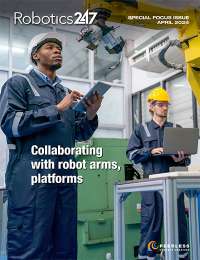As reported in The Wall Street Journal, a new generation of robots is on the way - smarter, more mobile, more collaborative and more adaptable.
They promise to bring major changes to the factory floor, as well as potentially to the global competitive landscape.
Robots deployed in manufacturing today tend to be large, dangerous to anyone who strays too close to their whirling arms, and limited to one task, like welding, painting or hoisting heavy parts.
The latest models entering factories and being developed in labs are a different breed. They can work alongside humans without endangering them and help assemble all sorts of objects, as large as aircraft engines and as small and delicate as smartphones. Soon, some should be easy enough to program and deploy that they no longer will need expert overseers.
That will change not only the way an increasing number of products are made. It could also mean an upheaval in the competition between companies and nations. As robots become less costly and more accessible, they should help smaller manufacturers go toe to toe with giants. By reducing labor costs, they also may allow the U.S. and other high-wage countries to get back into some of the processes that have been ceded to China, Mexico and other countries with vast armies of lower-paid workers.
Some of the latest robots are designed specifically for the tricky job of assembling consumer-electronics items, now mostly done by hand in Asia. At least one company promises its robots eventually will be sewing garments in the U.S., taking over one of the ultimate sweatshop tasks.
“Robots are going to change the economic calculus for manufacturing,” says Hal Sirkin, a Chicago-based senior partner of Boston Consulting Group. “People will spend less time chasing low-cost labor.”
The changing face
Today, industrial robots are most common in auto plants - which have long been the biggest users of robot technology - and they do jobs that don’t take much delicacy: heavy lifting, welding, applying glue and painting. People still do most of the final assembly of cars, especially when it involves small parts or wiring that needs to be guided into place.
Now robots are taking on some jobs that require more agility. At a Renault SA plant in Cleon, France, robots made by Universal Robots AS of Denmark drive screws into engines, especially those that go into places people find hard to get at. The robots employ a reach of more than 50 inches and six rotating joints to do the work. They also verify that parts are properly fastened and check to make sure the correct part is being used.
The Renault effort demonstrates a couple of trends that are drastically changing how robots are made. For one, they’re getting much lighter. The Renault units weigh only about 64 pounds, so “we can easily remove them and reinstall them in another place,” says Dominique Graille, a manager at Renault, which is using 15 robots from Universal now and plans to double that by year-end.
Researchers hope robots will become so easy to set up and move around that they can reduce the need for companies to make heavy investments in tools and structures that are bolted to the floor. That would allow manufacturers to make shorter runs of niche or custom products without having to spend lots of time and money reconfiguring factories. “We’re getting away from the [structures and machinery] that can only be used for one thing on the factory floor and [instead] using robots that can be easily repurposed,” says Henrik Christensen, director of robotics at Georgia Institute of Technology.
Built to Collaborate
Another big trend at work: The Renault robots are “collaborative,” designed to work in proximity to people. Older types of factory robots swing their steel arms with such force that they can bludgeon anyone who strays too close. Using sonar, cameras or other technologies, collaborative robots can sense where people are and slow down or stop to avoid hurting them.
These types of innovations aren’t limited to the auto industry. ABB Ltd of Switzerland, Boston-based Rethink Robotics Inc. and others have recently introduced robots designed to help assemble consumer-electronics items, among other products. These new robots are designed to work close to people and handle small parts, rather than doing heavy lifting or welding or painting.
Another aspect of doing more delicate work is the robots’ ability to sense whether parts are being assembled correctly, something that wasn’t possible with previous generations of clumsier robots. At a trade show in Germany in April, Kuka Roboter GmbH showed one of its robots installing a tube inside a dishwasher. Kuka’s robot uses “force torque” sensors to judge whether a part is in the right place. “The robot is able to wiggle it into place like a human would,” says Dominik Bösl, Kuka’s innovation manager.
This delicacy is allowing robotics to spread into a wider variety of industries. At a plant in Wichita, Kan., due to open in November, JCB Laboratories will use robots to pick up syringes, fill them with medications and snap on caps, among other tasks. The production line, designed by ESS Technologies Inc. of Blacksburg, Va., involves three robots from Japan’s Fanuc Corp. The robots will be five to six times faster than the people who now do the work, says Brian Williamson, president of JCB, owned by Fagron NV of Rotterdam.
Using robots also will reduce the risk of human error or contamination, he says: “They’re very precise, they don’t get tired, and they only do things they’re told to do.” The robots will eliminate two jobs, Mr. Williamson says, but the workers can be redeployed to other tasks.
Fender Musical Instruments Corp. uses Fanuc robots to apply polyester and urethane coatings to guitars at a plant in Corona, Calif. A spokeswoman says the robots apply coatings faster and more consistently than people could and allow people at the plant to “focus on areas that are more crucial to the overall look, feel and sound” of the instruments. Those tasks include designing, buffing and assembly.
Some in the robotics industry see machines moving into even more industries. Per Vegard Nerseth, ABB’s global robotics chief, expects increasing demand for robots from makers of watches, razors, toothbrushes and toys. He also thinks robots could help make muffins in local bakeries, slice vegetables and meat, and wash windows.
An Atlanta startup, SoftWear Automation Inc., which last year attracted $3 million of venture capital, has developed robots that the firm says can sew garments. The company hopes the robots will allow some clothing production to move back to the U.S. from low-wage nations.
Robots Everywhere?
But some caveats are in order for this rosy picture.
Though the U.S., Europe and other high-wage areas should benefit from these trends, they won’t have the field to themselves. China also is investing heavily in robots as its wages soar and its population ages. For now, China has just 30 robots per 10,000 manufacturing employees, trailing South Korea (437), Japan (323), Germany (282) and the U.S. (152), according to the International Federation of Robotics, a trade group. But the federation projects that the total number of industrial robots being used in China will exceed that of North America next year. IHS Technology, a research firm, projects that robot sales in China will surge to about 211,000 units in 2019 from 55,000 last year.
Competition among manufacturing nations isn’t only about robots, of course. Other factors that determine where things are made include taxes, regulation, availability of skilled workers and suppliers, energy costs and willingness to make long-term investments. At a minimum, though, investing in robots and using them effectively will be a price of staying in the global manufacturing game, says Mr. Sirkin of Boston Consulting Group. So even nations that rely on low-cost labor today will be forced to explore robotics or risk losing even more jobs.
Even if robots allow manufacturing to relocate, the impact on the workforce itself will be mixed. Greater use of robots means fewer people are needed on factory floors; those doing routine tasks requiring little education are most vulnerable. Yet even highly automated factories create or sustain jobs in design, engineering, machine maintenance and repair, marketing, logistics and other services.
What’s more, robots will have to make further strides in the years ahead to allow a major shift of electronics and other assembly work to migrate from Asia to the U.S. and Europe.
Speed Restrictions
One problem is that today’s collaborative robots frequently have to slow down or stop whenever people veer into their paths, disrupting production. Take the case of Baxter, a friendly looking two-armed collaborative robot from Rethink.
The company introduced Baxter with huge fanfare three years ago. Yet Rethink has sold fewer than 1,000 of the robot, which is mainly used for such simple tasks as moving materials, picking up parts, and packing or unpacking boxes. In part, that’s because the robot’s speed is restricted by safety considerations.
Rodney Brooks, chairman of Rethink and a renowned robot developer, says Baxter has been a “tremendous learning experience” and has helped manufacturers and others see the potential of collaborative robots. In March, Rethink unveiled a new robot, Sawyer, which the company says will be up to twice as fast as Baxter, depending on the application.
Another hurdle is creating robots that can come closer to matching people’s fine motor skills in manipulating materials and small parts. For all the advances in recent years, robots have trouble dealing with soft or floppy things, such as cloth or bundles of electrical wire.
“Anywhere you manipulate flexible materials, that’s a very challenging task for robots,” says Julie Shah, an assistant professor at the Massachusetts Institute of Technology. People use “tactile feedback,” Dr. Shah says. If something doesn’t feel quite right, they adjust. Robotic science is only starting to deal with that challenge.
Source: The Wall Street Journal
Article topics
Email Sign Up
























